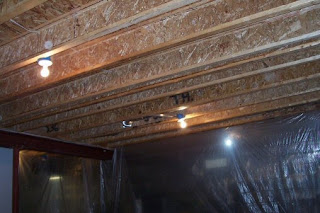
Unless you happen to be totally ignorant on the subject, finishing of a basement ceiling is not too difficult a project. For getting started it would do you good to read about in general on the types of basement ceilings. Let’s get started with the dry- walled ceiling. Now, this kind a ceiling involves a lot of labor and you may have to hire some equipment. It is not easy to install and is quite messy as compared to other kinds of ceilings. Should you get concerned about approaching wires and pipes going thru the ceiling, you can integrate that in the design or provide an inlet. Make use of trimmings or colorful tiles to highlight the ceiling.
You next option for the basement could be a dropped or suspended ceiling. Its construction comprises of grid work of metallic bars in the shape of an inverted “T” which are suspended with wires from the overhead joists. The advantage of such s ceiling is that you are not required to shift pipes; wires or ducts and the ducts may not be straight to give a flat appearance to the ceiling. Thus you continue to have an easy access to cooling, heating and electrical network. Finally, you can conveniently add a few lighting fixtures. Such a ceiling has another advantage of keeping away the unwanted noise from above. But, it has a limitation also. This design of ceiling occupies a lot of your vertical space, thereby reducing the effective height of the ceiling. So you get limited head space and in case the height of your ceiling is already low, it may not be very viable to go for this type of ceiling.
There are a few tricks to conceal an unsightly ceiling and these have proven to be workable. Of course, you have to put in some extra effort to make it look beautiful, but they are worth taking that trouble.
The most convenient way to conceal a not so pleasant looking ceiling is to have a suspended or dropped ceiling. Such a ceiling comprises of a grid work of metal bars in the form of an inverted “T”, suspended from the ceiling by means of overhead joists.
Here are the advantages of a suspended ceiling:
- You don’t have to wires, pipes or ducts
- It doesn’t really matter even if the joists are not straight for the finished ceiling to look flat
- You can approach the heating, cooling and electrical systems or add lighting fixtures by just removing a panel.
- It acts as a barrier to the unwanted noise from above
One big drawback of a suspended ceiling is that it eats into your vertical space, thereby limiting your headspace. If the height of your ceiling is already low, you have to look for some other option.
Another option that you have is to install a drywall basement ceiling. Though it is a difficult project, it gives a very professional look. For getting more of headroom under the ceiling, you can relocate some pipes and wires before installing such a ceiling. Larger obstacles like ducts have to be boxed for a neat look.
The benefits of having a dry wall are:
- It provides an excellent base for paint and other materials, like wood panels
- It has fire-resistant characteristics
- It gives a very professional look
- It is relatively economical
It will be good to spend sometime to study your requirements and then take the best course of action. It all depends upon the kind of items you want to keep away from sight and the amount of labor and money you are willing to invest. Well, each kind has its plus and negative points and you have to decide which would be most helpful for the purpose you have in mind.